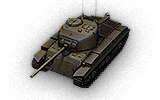Select your region to log in.
Crew:
- Commander
- Radio Operator
- Driver
- Gunner
- Loader
Advantages:
- Good alpha damage and above average penetration (especially with APCR), without suffering from poor gun handling or aim time
- Good speed allows the T20 to charge at distracted enemies, unload a shell and evade retaliation
- Excellent gun depression
- Great view range for its tier
- Low profile gives it very good camo value
Disadvantages:
- Almost non existing armor
- Ammo rack is very fragile
- Very Low damage-per-minute output
- Bad accuracy and aim time
- Significant agility downgrade from M4A3E8, although really good speed and acceleration
Tank description:
The T20 is an American tier 7 medium tank.The first in a series of 1942–1943 U.S. medium tank designs intended as replacements for the M4 Sherman. The first prototype was produced in May 1943, and trials went on until 1944. The vehicle was not approved for mass production, but subsequent prototypes, the T22 and T23, were created on the basis of this development. They, in turn, served as precursors of the T25 and T26. Eventually, the M26 Pershing emerged on their basis and was adopted for service.Much like the M4A3E8 Sherman, the T20 lacks significant armor. Able to sneak around the battlefield, the T20 is an excellent support tank and able to switch between engagements in very short time. Its thin armor is a serious weakness, and caution must be taken to avoid enemy fire whenever possible. Pick different strategies to match different opponents: flank heavy tanks, ambush and brawl mediums, track and destroy lights. Passive scouting is viable when other scouts are not available.The T20 leads to the T69, and the M26 Pershing.
The first in a series of 1942–1943 U.S. medium tank designs intended as replacements for the M4 Sherman. The first prototype was produced in May 1943, and trials went on until 1944. The vehicle was not approved for mass production, but subsequent prototypes, the T22 and T23, were created on the basis of this development. They, in turn, served as precursors of the T25 and T26. Eventually, the M26 Pershing emerged on their basis and was adopted for service.

 Русский
Русский English
English Russian region
Russian region North-american region
North-american region European region
European region Asia region
Asia region Korean region
Korean region


 55 500
55 500
 930 500
930 500




